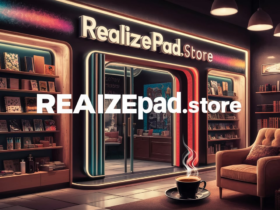In today’s fast-paced digital world, emerging technologies are redefining how we approach problem-solving, data analysis, and systems optimization. One such technological breakthrough is methatreams.
This groundbreaking concept is rapidly gaining attention from businesses, researchers, and technologists due to its potential to revolutionize various industries. But what exactly are methatreams, and how can you leverage them to stay ahead of the curve? In this comprehensive guide, we will break down everything you need to know about methatreams, from their foundational principles to their real-world applications.
What Are Methatreams?
Methatreams represent a sophisticated system for processing, analyzing, and manipulating streams of data in real-time, combining the best practices of metadata and data stream management. It’s an advanced methodology that enables more efficient data-driven decision-making by blending metadata (data about data) with streaming data architectures. Methatreams allow for the enhancement of data streams by providing context, structure, and actionable insights without needing to store massive volumes of data.
At its core, methatreams work by processing metadata alongside the actual data stream, making it easier to perform tasks like filtering, categorizing, and transforming real-time information. With methatreams, the integration of metadata boosts the overall quality of data analysis and enables more dynamic, responsive systems.
The Importance of Methatreams in the Digital Age
The sheer amount of data generated today is staggering, from social media posts to IoT (Internet of Things) devices to business transactions. Processing all this information in real time is crucial for businesses to make agile decisions and stay competitive. However, without a robust framework for managing both data and metadata efficiently, even the most sophisticated systems can become overwhelmed by the volume of information.
Methatreams help solve this problem by offering a way to process data in real time while maintaining essential context through metadata. This leads to more informed decision-making and a faster response to market changes, customer behaviors, and system needs. With methatreams, companies can go beyond simple data collection, focusing on extracting actionable insights that are both timely and contextually relevant.
How Methatreams Work: A Deep Dive
To understand methatreams, it’s important to break down their two key components: metadata and data streams.
- Metadata: Metadata is often described as “data about data.” It provides crucial information about the structure, format, origin, and other characteristics of the data. In methatreams, metadata plays a vital role in providing context to raw data streams. It ensures that incoming data is labeled, categorized, and understood in a way that makes it easier to analyze and act upon.
- Data Streams: Data streams refer to the continuous flow of data generated by various sources, often in real-time. This includes anything from user clicks on a website to temperature readings from an IoT sensor. Methatreams improve traditional data streams by including metadata within the stream itself, making the data more accessible and meaningful.
The combination of these two components creates a system where raw data is accompanied by information that helps to interpret, transform, and analyze it in real time. This has significant implications for sectors such as finance, healthcare, and e-commerce, where real-time data processing is critical for success.

Applications of Methatreams Across Industries
Methatreams are a versatile tool that can be applied in numerous industries. Here are some of the most impactful use cases:
- Finance and Stock Trading
In the finance industry, milliseconds matter. The ability to process market data and execute trades at lightning speed can be the difference between profit and loss. Methatreams provide traders with an enhanced ability to analyze streaming data in real time, accompanied by metadata that adds crucial context. For instance, trading algorithms can benefit from methatreams by identifying trends and executing trades based on real-time market conditions, bolstered by metadata about each transaction.
- Healthcare
Healthcare generates vast amounts of data, from patient records to real-time monitoring devices. With methatreams, healthcare providers can process streams of data from medical devices in real-time, giving doctors and nurses up-to-the-minute information on a patient’s condition. The accompanying metadata, such as the time and type of measurement, ensures that healthcare professionals are not just getting data—they’re getting actionable, well-contextualized insights that can inform treatment plans.
- E-commerce and Marketing
E-commerce platforms handle enormous amounts of data on customer behavior, purchasing habits, and product preferences. Methatreams allow companies to process this information as it’s generated, enabling hyper-personalized recommendations, dynamic pricing, and real-time inventory management. By integrating metadata into the data stream, businesses can better understand customer behavior, helping them offer targeted promotions and improve user experiences.
- Internet of Things (IoT)
IoT devices, from smart homes to connected cars, generate real-time data continuously. Methatreams enhance IoT ecosystems by adding a layer of metadata that provides context to the raw data produced by sensors, cameras, and other devices. This metadata could include information about the source of the data, the location of the device, and the specific condition being measured. Methatreams ensure that IoT systems are more efficient, scalable, and capable of handling complex, real-time interactions.
Key Benefits of Implementing Methatreams
There are several compelling reasons why organizations should consider integrating methatreams into their data processing architecture:
- Enhanced Real-Time Analytics
By combining metadata with real-time data streams, methatreams provide a clearer, more complete picture of ongoing processes. This leads to enhanced decision-making capabilities and more accurate insights.
- Improved Data Quality and Context
One of the biggest challenges in handling big data is ensuring that the data is both high-quality and meaningful. Methatreams help address this issue by integrating metadata directly into the data stream, giving organizations the context they need to make better use of the data.
- Scalability
As data grows, so too must the systems that process it. Methatreams are designed to be highly scalable, making them an ideal solution for businesses that anticipate continued growth in the volume and complexity of their data streams.

- Faster Response Times
In sectors where speed is crucial—such as finance or healthcare—methatreams enable systems to respond to changes more quickly by providing real-time insights and decision support. This rapid response time can lead to competitive advantages in the marketplace.
Challenges and Considerations When Adopting Methatreams
As with any technological solution, methatreams are not without their challenges. Organizations considering adopting methatreams should be aware of several potential hurdles:
- Complexity
While methatreams provide significant benefits, they can also introduce complexity to existing systems. Organizations may need to invest in new infrastructure and retrain employees to manage and interpret methatreams effectively.
- Data Privacy and Security
With the rise of real-time data processing comes the challenge of ensuring data privacy and security. Methatreams, which handle sensitive information in real time, require robust encryption and access control measures to protect against breaches.
- Integration with Legacy Systems
Many organizations still rely on legacy systems for data processing. Integrating methatreams with these older systems can be a challenge, requiring careful planning and potentially significant investment in new technology.
Future of Methatreams
The future of methatreams looks incredibly promising. As the need for real-time data processing continues to grow, so too will the demand for systems that can efficiently manage both data and metadata streams. Innovations in AI, machine learning, and edge computing will likely accelerate the adoption of methatreams, opening up new opportunities in industries ranging from manufacturing to entertainment.
Conclusion
Methatreams are a transformative technology that can provide organizations with faster, more accurate insights and improved decision-making capabilities. By integrating metadata directly into data streams, methatreams offer a powerful way to manage the growing volume and complexity of real-time data. Whether you’re in finance, healthcare, e-commerce, or any other data-intensive industry, mastering methatreams could be the key to staying competitive in the digital age.
Do Raed: Dehea Abraham: Love Life, Relationships, Popularity & Insights













Got a Questions?
Find us on Socials or Contact us and we’ll get back to you as soon as possible.